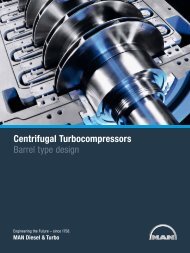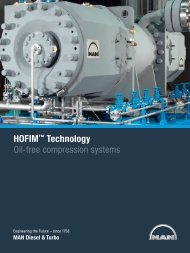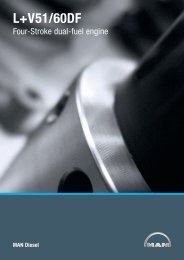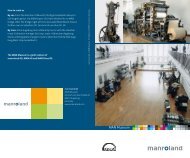Service Experience - MAN Diesel & Turbo - 首页
Service Experience - MAN Diesel & Turbo - 首页
Service Experience - MAN Diesel & Turbo - 首页
You also want an ePaper? Increase the reach of your titles
YUMPU automatically turns print PDFs into web optimized ePapers that Google loves.
<strong>Service</strong> <strong>Experience</strong> Update<br />
ME System<br />
Over the past years, we have described<br />
various areas with room for improvement<br />
on the ME system in a number<br />
of papers dealing with service experience.<br />
The most recent paper is <strong>Service</strong><br />
<strong>Experience</strong> 2008, <strong>MAN</strong> B&W Engines,<br />
Ref. [1].<br />
In this paper, we will comment on is-<br />
sues which are still undergoing investi-<br />
gation at the time of writing. Also, future<br />
planned upgrades will be mentioned.<br />
Especially the trouble-shooting tools<br />
implemented in a new ECS software<br />
version will be commented on.<br />
Cavitation damage in the exhaust valve<br />
actuation system<br />
Fig. 1 shows cavitation damage in the<br />
high pressure pipe between the exhaust<br />
actuator and the exhaust valve.<br />
Also cavitation damage in the actuator<br />
top cover and in the top of the exhaust<br />
valve can be seen. This kind of damage<br />
is seen on the large bore versions of the<br />
ME engine (80, 90 and 98-cm bore),<br />
Fig. 1: Cavitation in hydraulic exhaust actuation system<br />
4 <strong>Service</strong> <strong>Experience</strong> of <strong>MAN</strong> B&W Low Speed <strong>Diesel</strong> Engines<br />
however, not to the same extent on all<br />
units on the engine. Therefore, damage<br />
can be counteracted by relatively small<br />
changes.<br />
<strong>Service</strong> tests where the proportional<br />
feature of the FIVA valve is used are<br />
70<br />
60<br />
50<br />
40<br />
30<br />
20<br />
10<br />
Use of Proportional (FIVA) Control for Exhaust Valve Actuation<br />
0<br />
4000 4500 5000 5500 6000 6500 7000 7500 8000<br />
Fig. 2: Use of proportional (FIVA) control for exhaust valve actuation<br />
presently ongoing. So far, we have only<br />
used the proportional control of the FIVA<br />
valve for injection rate shaping, but now<br />
we also use it in order to open and close<br />
the exhaust valve gently. Fig. 2 shows<br />
the original lifting curve and the modified<br />
lifting curve of the exhaust valve. No<br />
Cyl. 6 Exhaust valve org.<br />
Cyl. 7 Exhaust valve test.








